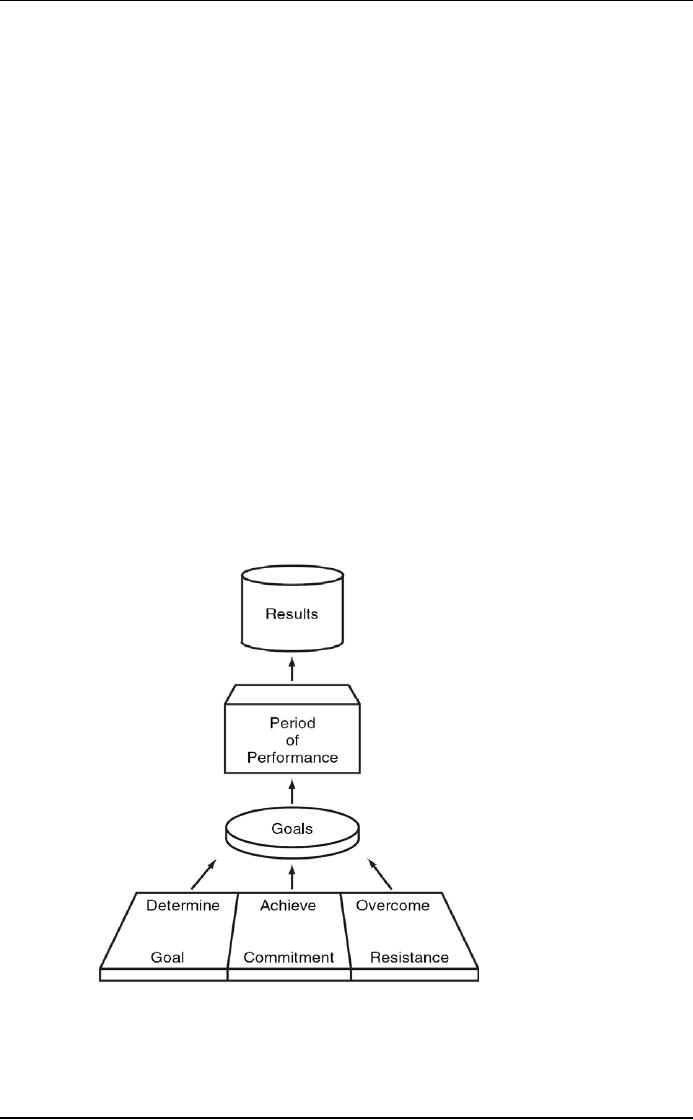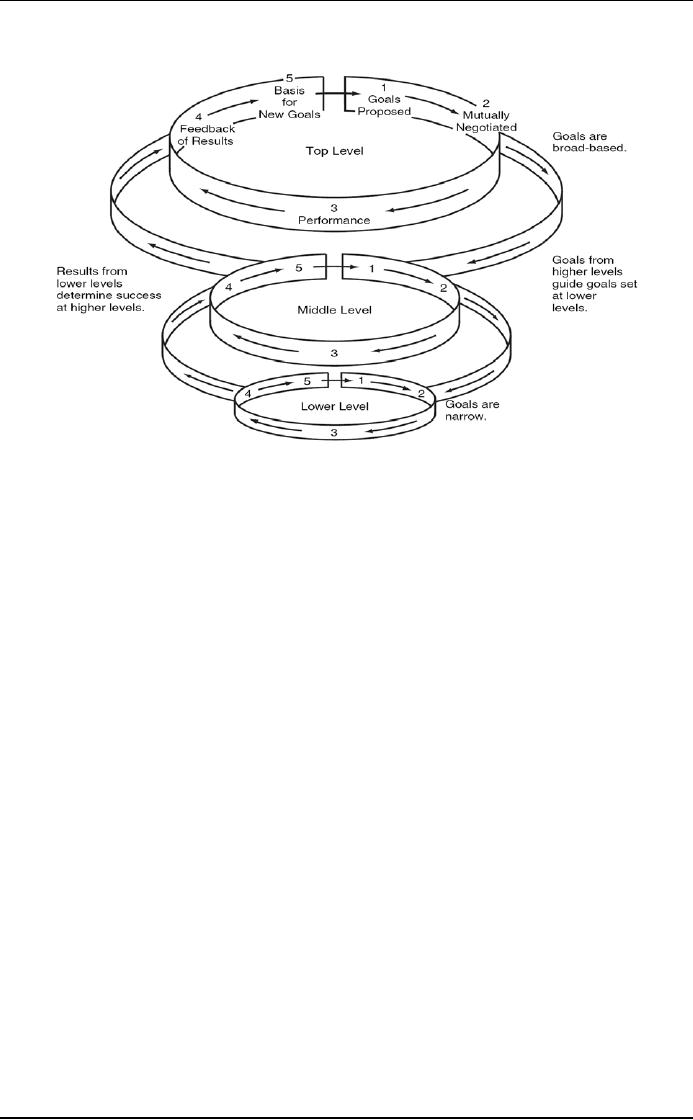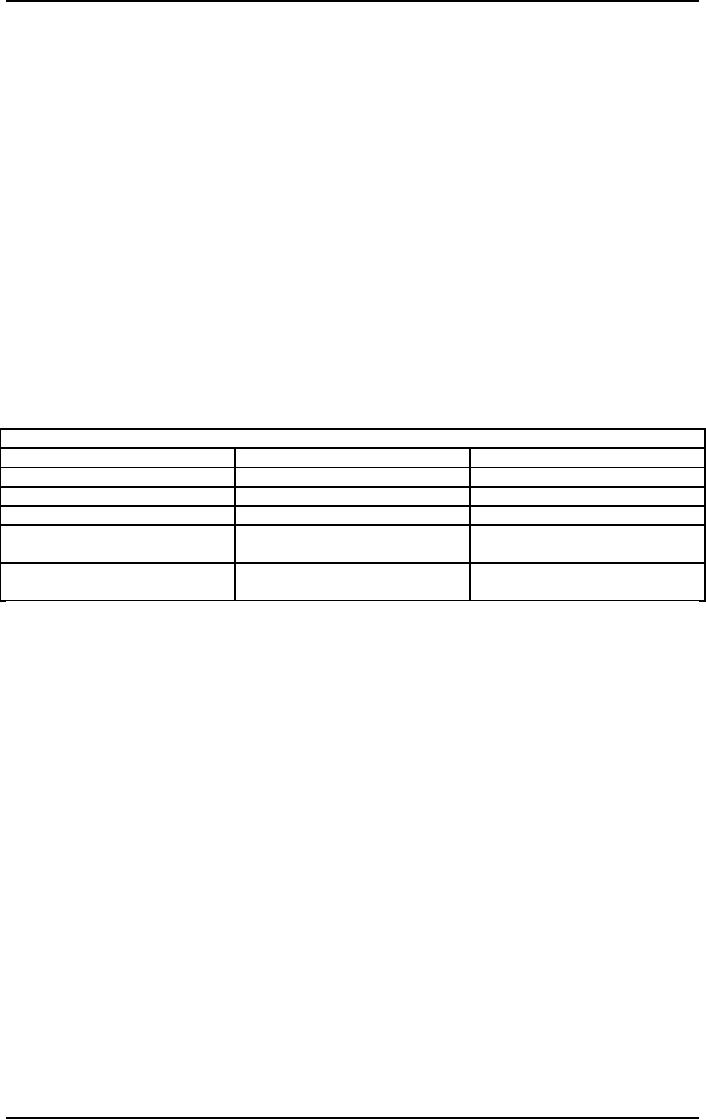 |

Organization
Development MGMT
628
VU
Lesson
39
Performance
Management
We
discuss human resources
management interventions concerned
with managing individual and
group
performance.
Performance management involves
goal setting, performance
appraisal, and reward
systems
that
align member work behavior
with business strategy,
employee involvement, and workplace
technology.
A
Model of Performance
Management:
Performance
management is an integrated process of
defining, assessing, and
reinforcing employee
work
behaviors
and outcomes. Organizations with a
well-developed performance management
process often
outperform
those without this element of
organization design. As shown in Figure
52, performance
management
includes practices and
methods for goal setting,
performance appraisal, and
reward systems.
These
practices jointly influence the
performance of individuals and
work groups. Goal setting
specifies the
kinds
of performances that are
desired; performance appraisal
assesses those outcomes;
reward systems
provide
the reinforces to ensure that
desired outcomes are
repeated. Because performance
management
occurs
in a larger organizational context, at least
three contextual factors determine
how these practices
affect
work performance: business
strategy, workplace technology, and
employee involvement. High
levels
of
work performance tend to
occur when goal setting,
performance appraisal, and
reward systems are
aligned
jointly with these contextual
factors.
Figure:
52
Business
strategy defines the goals
and objectives that are
needed for an organization to
compete
successfully,
and performance management
focuses, assesses, and
reinforces member work
behaviors
toward
those objectives. This
ensures that work behaviors
are strategically
driven.

Organization
Development MGMT
628
VU
Workplace
technology affects whether performance
management practices should be based on
the
individual
or the group. When technology is low in
interdependence and work is
designed for
individual
jobs,
goal setting, performance
appraisal, and reward
systems should be aimed at individual
work behaviors.
Conversely,
when technology is highly interdependent
and work is designed for
groups, performance
management
should be aimed at group
behaviors.
Finally,
the level of employee involvement in an organization
should determine the nature of
performance
management
practices. When organizations
are highly bureaucratic with
low levels of participation,
goal
setting,
performance appraisal, and
reward systems should be formalized and
administered by management
and
staff personnel. In high-involvement
situations, on the other hand,
performance management should
be
heavily participative, with both
management and employees
setting goals and appraising
and rewarding
performance.
In high-involvement organizations, for
example, employees participate in all
stages of
performance
management are heavily involved in
both designing and administering
its practices.
Goal
Setting
OD
in Practice: Big Hairy
Audacious Goals
Employees
at the Generic Electric are aiming at "stretch
goals." At GE, stretch goals
means encouraging
employee
teams to try for huge
gains in productivity and
quality even though, at the
outset, it is unclear
how
they will get there, based
on certainty that they will use
their ingenuity to find ways
to do what they are
asked.
At other companies they call
these goals BHAG big hairy
audacious goals. These are
the kind of
goals
that stimulate everyone in the
organization to shoot for extreme
achievement. One thinks,
for
instance,
of the NASA moon mission.
The NASA goal energized the
entire country.
One
major goal that GE is striving
for is called Six Sigma.
This program is the largest quality
initiative ever
mounted
at a U.S. corporation. Six
Sigma is a statistical term for
3.4 defects per million
products. This
translates
to near-perfect manufacturing. GE began implementing
Six Sigma in the mid-1990s,
when
Lawrence
Bossidy, who at the time was
CEO of AlliedSignal, spoke to GE's
top management about the
concept.
Bossidy had been using
Six Sigma at AlliedSignal
for about five years. He
had borrowed it from
Motorola.
All three companies,
Motorolla, AlliedSignal, and GE,
have placed, and continue to
place,
substantial
resources into Six Sigma
programs. GE has a way to go before it
attains its goals. Currently
GE
is
running at three to four
Sigma level. The gap between
that and a six level is
costing GE between $8
billion
and $12 billion a year in
lost productivity and inefficiencies. To
attain a goal of Six Sigma
requires
more
than an edict from the CEO. It
requires every employee to
get on board and "walk the
talk." For a
company
the size of GE, this is a gargantuan
task. Six Sigma is difficult
to understand because of its
heavily
laden
statistical concepts. It is even
more difficult to implement. Last
year GE spent $600 million
on Six
Sigma
projects mostly for the salaries of
4,000 full-time Six Sigma
experts plus 100,000
employees to
undergo
basic training.
As
the program at the GE illustrates, goals give
direction and purpose. It is
difficult to imagine an
organization
that does not have
goal setting of some kind.
In a large and established
company, goal-setting
may
be a formal program as the development of an ideal
model of the organization or the implementation
of
a management by objective program. On the
other hand, in a newly opened
business, goal setting
may
take
the form of a mental image of what the
business will be like in a
year and then five
years from now.
OD
programs rely heavily upon the
goal-setting process. OD, by
definition, is planned change. In order
for
that
change to take place, goals
need to be set to establish what the
organization will be like. And
then plan
a
series of steps that will
move the organization to accomplish the
goals.
Goal
setting involves managers
and subordinates in jointly
establishing and clarifying
employee goals. In
some
cases, such as management by
objectives, it also can facilitate
employee counseling and support.
The
process
of establishing challenging goals
involves managing the level of participation
and goal difficulty.
Once
goals have been established,
the way they are measured is an
important determinant of member
performance.
Goal
setting can affect performance in
several ways. It influences what people
think and do by
focusing
their
behavior, motivating people to put
forth the effort to reach
difficult goals that are
accepted, and when
goals
are difficult but
achievable, goal setting prompts
persistence over time. Goal-setting
interventions
have
been implemented in such organizations as
GE, 3M, AT&T Universal Card,
and Occidental
Petroleum's
subsidiary Oxy-USA.

Organization
Development MGMT
628
VU
Characteristics
of Goal Setting
Challenging
goals produce better
performance:
Goals
are only effective if they are
difficult and challenging.
Increasing the difficulty of employee
goals, also
known
as "stretch
goals" can
increase their perceived
challenge and enhance the amount of
effort
expended
to achieve them. Thus, more
difficult goals tend to lead
to increased effort and
performance, as
long
as they are seen as
feasible.
Specific
hard goals are better than
"do your best"
Goals:
Goal
setting involves specifying
and clarifying the goals.
When given specific goals,
workers perform higher
than
when they are simply told to "do
their best" or when they receive no
guidance at all.
People
may abandon goals if too
hard:
Although
goals should be difficult, people must be
able to attain or at least approach
them; otherwise, they
will
view the goal as impossible,
become discouraged, and may
abandon it. An individual is
more likely to
accept
or choose a goal when there
is a high expectation of reaching it. If
goals are set too
high, people may
lose
their motivating
potential.
Participation
in setting goals increases
commitment and attainment of
goals:
Employees
are more committed to self-set
goals than to goals assigned
by a manager. It gives them
ownership.
Feedback
and goals improve
performance:
Information
about the outcome of the performance,
whether a goal was met or
not, should be included. It
is
also important to include information
about how to adjust in order
to accomplish the goal
better.
Individual
differences tend not to
affect goal
setting:
Goal
setting programs are
successful regardless of education and
position. Production workers,
clerical
workers,
maintenance workers, managers,
all can use goal
setting successfully. CEO of
Wal-Mart claims,
"There
are no superstars. We're a
company of ordinary people
overachieving."
Goal-setting
in teams deserves special
consideration:
Setting
difficult individual goals
for an interdependent team task
will likely result in poorer
performance
than
when a team goal is set or
even when there is no team
goal at all.
A
manager explicitly specifying
which goal is more important
can achieve cooperation in goal
setting.
Another
to get cooperation is through participative
goal setting in the context of a
team-building session.
Support
of management is critical:
Support
for goal-setting programs by
all levels of management is
crucial to the success. Leaders
should
maintain
optimism by publicizing even small
steps forward. Supervisors should be
present to encourage the
acceptance
of goals by employees, help them
improve their skills, and
give timely feedback on how
the
goals
are being accomplished. Those
who accomplish goals should be
rewarded, but the rewards
need to be
applied
consistently.
Application
Stages:
Based
on these features of the goal-setting
process, OD practitioners have developed
specific approaches
to
goal setting. The following
steps characterize those
applications:
1.
Diagnosis. The
first step is a thorough
diagnosis of the job or work
group; employee needs; and
the
three
context factors, business
strategy, workplace technology, and level of
employee involvement. This
provides
information about the nature
and difficulty of specific
goals, the appropriate types and
levels of
participation,
and the necessary support
systems.
2.
Preparation for goal
setting. This
step prepares managers and
employees to engage in goal
setting,
typically
by increasing interaction and
communication between managers and
employees, and
offering
formal
training in goal- setting
methods. Specific action plans
for implementing the program also are
made
at
this time.
3.
Setting of goals. In this
step challenging goals are
established and methods for
goal measurement are
clarified.
Employees participate in the process to extent
that contextual factors support such
involvement
and
got the extent that they are
likely to set higher goals
than those assigned by
management.
4.
Review. At this
final step the goal-setting
process is assessed so that
modifications can be made,
if
necessary.
The goal attributes are
evaluated to see the goals are
energizing and challenging
and whether they
support
he strategy and can be influenced by the
employees.
Goal-Setting
Model:
A
goal setting program in an organization
requires careful planning. As
shown in the figure, the first
three
factors
in goal-setting process are
establishing the goal, achieving
goal commitment, and overcoming
resistance
to goal acceptance.
Goals
can be established in a variety of ways.
Best way is to set by joint
participation between the
employee
and the supervisor. This method often
leads to employee commitment, a crucial
ingredient in
effective
goal setting.

Organization
Development MGMT
628
VU
Goal
commitment can be achieved in a variety of
ways. Trust in upper management,
support by
management,
and an effective reward and incentive
system are all helpful in
commitment. Competition
between
employees may be useful in
some cases, but managers
should be careful designing
competitive
situations,
especially in interdependent situations.
Employees may become so
involved in competing with
one
another, that they lose sight of the
goals.
Resistance
to goal acceptance can be
overcome by several methods,
and a combination of methods
will
likely
result in a more successful
goal-setting program. Providing
special training for
employees in new
techniques
and procedures and providing
rewards and incentives can
encourage goal
acceptance.
Participation
in setting goals can lead
some employees to accept
goals.
Goals
should be specific, measurable, and
compatible with the goals formulated at
higher levels of the
organization.
As an example of goal setting
Bell Canada's telephone operators
are required to answer
calls
within
23 seconds and Federal
Express customer agents are
expected to answer customer
questions within
140
seconds. Both goals were
considered very difficult when
initially set, but employees
eventually met and
exceeded
these goals.
A
period of performance follows
upon the setting of specific
performance goals during this time,
managers
must
be prepared to provide support. To
achieve specific goals,
employees may require training
or
additional
resources, such as new equipment or
information. Managers may
need to work with
employees
in
developing action plans. Finally,
managers should provide timely
and objective feedback when the goal
is
completed.
The
results of the employees' performance
can be beneficial or negative. The
benefits may incur to
the
organization
or the individual. When individuals
successfully meet a goal, they feel
competent and
successful.
Better performance and pride in the
achievement of successes can be
expected. Employees
are
more
likely to have clearer roles
if they more fully realize the
performance expected of them.
Negative
consequences
can be expected when the
goals are not achieved.
This is most problematic in
situations
where
specific and measurable
goals could not be
set.
Figure
53: Goal Setting
Management
by Objectives:
MBO
is a specific technique used by
organizations to set goals. It is a
process aimed at the integration
of
individual
and organization goals. MBO
may be defined as a system of
management set up to help
in
planning,
organizing, problem-solving, motivating, and
other important managerial
activities. It involves the
participation
of subordinates and their
managers in setting and
clarifying the goals for
subordinates. A
leading
MBO consultant defines it as a process
whereby the superior and subordinate
managers of an

Organization
Development MGMT
628
VU
organization
jointly identify common goals, define
each individual's major areas of
responsibility in terms
of
results expected, and use
these measures as guides for
operating the unit and assessing the
contribution
of
each of its members. The
goals of this approach include improved
performance, more communication
and
participation, higher morale and
job satisfaction, and a better
understanding of the organization's
objectives
at all levels.
MBO
approaches goal-setting on the assumption
that people have higher-level needs
for competence and
achievement,
and want to satisfy these higher-level
needs in their work. In
addition, people will work
harder
and
perform better if they participate in setting
goals they have to
achieve.
An
MBO program often goes beyond the
one-on-one, manager-subordinate relationship to focus
on
problem-solving
discussions involving work
teams as well. Setting goals
and reviewing individual
performance
are considered within the
larger context of the job. In
addition to organizational goals,
the
MBO
process gives attention to
individuals' personal and
career goals and tries to
make those and the
organizational
goals more complementary.
The target-setting procedure
allows real subordinate
participation
in goal setting, with open,
problem-centered discussions among team
members, supervisors,
and
subordinates.
Steps
in MBO Process:
There
are six basic steps in
implementing an MBO process.
1.
Work group involvement. In the
first step of MBO, the
members of the primary work group
define
overall
group and individual goals
and establish action plans
for achieving them. If this
step is omitted or if
organizational
goals and strategies are
unclear, the effectiveness of an MBO
approach may be
greatly
reduced
over time.
2.
Joint manager-subordinate goal setting.
Once
the work group's overall
goals and responsibilities
have
been determined, attention is given to
the job duties and responsibilities of
the individual role
incumbents.
Roles are carefully examined in
light of their interdependence
with the roles of others
outside
the
work group.
3.
Establishment
of action plans for goals.
The
subordinate develops action plans for
goal
accomplishment,
either in a group meeting or in a meeting
with the immediate manager.
The action plans
reflect
the individual style of the subordinate,
not that of the
supervisor.
4.
Establishment of criteria, or yardsticks, of success.
At this
point, the manager and
subordinate
agree
on the success criteria for the goals
that have been established--criteria
that are not limited to
easily
measurable
or quantifiable data. A more
important reason for jointly
developing the success criteria is to
ensure
that the manager and subordinate
have a common understanding of the task
and what is expected
of
the subordinate. Frequently, the parties
involved discover that they
have not reached a
mutual
understanding.
The subordinate and the manager
may have agreed on a certain
task, but in discussing
how
to
measure its success, they
find that they have not
been communicating clearly. Arriving at
joint
understanding
and agreement on success criteria is the
most important step in the entire
MBO process.
5.
Review and recycle. Periodically, the
manager reviews work
progress, either in the larger group
or
with
the subordinate. There are three
stages in this review process. First, the subordinate
takes the lead,
reviewing
progress and discussing
achievements and the obstacles
faced. Next, the manager
discusses work
plans
and objectives for the
future. Last, after the action plans
have been made, a more
general discussion
covers
the subordinate's future ambitions and
other factors of concern. In this
final phase, a great deal
of
coaching
and counseling usually takes
place.
6.
Maintenance of records. In
many MBO programs, the
working documents of the goals,
criteria,
yardsticks,
priorities, and due dates
are forwarded to a third
party. Although the evidence is
indirect, it is
likely
that the MBO program, as an OD
effort, suffers when the working
papers are reviewed regularly by
a
third
party, such as higher management or the
personnel department. Experience shows
that when the
working
papers routinely are passed
on, they are less likely to
reflect open, honest communication
within
the
supervisor-subordinate pair or the work
group. Often they represent instead an
effort to impress the
third
party or to comply with institutionalized
rules and procedures.

Organization
Development MGMT
628
VU
Figure
54: Steps in the MBO
Process
Criticism
of MBO:
Implementing
MBO is expensive and
time-consuming, and usually
entails great effort.
Because of these
factors,
the use of MBO has
traditionally been limited to
managerial and professional
employees. Obtaining
benefits
whose value exceeds the
costs is more difficult with
employees performing routine
work at the
lower
levels of an organization.
Some
MBO programs encounter difficulties
because management does not
recognize that proper
implementation
of MBO requires improved
managerial skills and
competence. Critics question
whether
joint
goal-setting among un-equals is
possible, and whether subordinates at
lower levels are free to
select
their
objectives. In some application
MBO may be too quantitative,
and setting objectives as
explicitly as
possible
may not be functional. In
other MBO programs, communication
may come from the top
dictating
to
the bottom instead of open communication
and mutual goal setting.
Thus there is also a danger
that
MBO
will focus only on certain
aspects of the job (such as
sales) and ignore other
areas (for example,
customer
satisfaction).
Performance
Appraisal:
Performance
appraisal is a feedback system
that involves the direct evaluation of
individual or work
group
performance
by a supervisor, manager, or peers.
Most organizations have some
kind of evaluation system
that
is used for performance
feedback, pay administration/and, in
some cases, counseling and
developing
employees.
Thus, performance appraisal
represents an important link
between goal-setting processes
and
reward
systems. One survey of more
than five hundred firms
found that 90 percent used
performance
appraisal
to determine merit pay increases, 87
percent used it to review performance,
and 79 percent used
it
as
the opportunity to set goals
for the next period.
Abundant
evidence, however, indicates that
organizations do a poor job
appraising employees. One
study
found
that 32 percent of managers
surveyed rated their
performance appraisal process as very
ineffective.
Consequently,
a growing number of firms have sought
ways to improve performance
appraisal. Some
innovations
have been made in enhancing
employee involvement, balancing
organizational and employee
needs,
and increasing the number of raters.
These newer forms of appraisal
are being used in
such
organizations
as AT&T, Raychem, Levi Strauss,
Intel, and Monsanto.
The
Performance Appraisal
Process:
Table
18 summarizes several common elements of
performance appraisal systems.
For each element,
two
contrasting
features are presented,
representing traditional bureaucratic
approaches and newer,
high-
involvement
approaches. Performance appraisals
are conducted for a variety of
purposes, including
affirmative
action, pay and promotion
decisions, and human
resources planning and development.
Because
each
purpose defines what performances
are relevant and how they should be
measured, separate
appraisal

Organization
Development MGMT
628
VU
systems
are often used. For
example, appraisal methods
for pay purposes are
often different from
systems
that
assess employee development or
promotability. Employees also
have a variety of reasons for
wanting
appraisal,
such as receiving feedback
for career decisions, getting a
raise, and being promoted.
Rather than
trying
to meet these multiple
purposes with a few standard
appraisal systems, the new
appraisal approaches
are
more tailored to balance the
multiple organizational and employee
needs. This is accomplished by
actively
involving the appraisee, co-workers,
and managers in assessing the
purposes of the appraisal at the
time
it takes place and adjusting the
process to fit that purpose.
Thus, at one time the appraisal
process
might
focus on pay decisions, another time on
employee development, and still another
time on employee
promotability.
Actively involving all relevant
participants can increase the chances
that the purpose of the
appraisal
will be correctly identified and
understood and that the appropriate
appraisal methods will
be
applied.
The
new methods tend to expand
the appraiser role beyond managers to
include multiple raters, such
as
the
appraisee, co-workers, and
others having direct exposure to the
employee's performance. Also
known
as
360-degree feedback, this broader
approach is used more for
member development than
for
compensation
purposes. This wider involvement provides
a number of different views of the
appraisee's
performance.
It can lead to a more
comprehensive assessment of the
employee's performance and
can
increase
the likelihood that both organizational
and personal needs will be
taken into account. The
key task
is
to form an overarching view of the
employee's performance that
incorporates all of the
different
appraisals.
Thus, the process of working
out differences and arriving
at an overall assessment is an
important
aspect of the appraisal process. This
improves the appraisal's acceptance, the
accuracy of the
information,
and its focus on activities
that are critical to the business
strategy.
Table
18
Performance
Appraisal Elements
Elements
Traditional
Approaches
High-involvement
Approaches
Purpose
Organizational,
legal fragmented
Developmental
Integrative
Appraiser
Supervisor,
managers
Appraise,
co-workers and others
Role
of appraise
Passive,
recipient
Active
participant
Measurement
Subjective
Objective
and subjective
Concerned
with validity
Training
Periodic,
fixed, administratively
Dynamic,
timely, employee or
driven
work-driven
The
newer methods also expand
the role of the appraiser. Traditionally,
the employee is simply a receiver
of
feedback. The supervisor unilaterally
completes a form concerning
performance on predetermined
dimensions,
usually personality traits, such as
initiative or concern for
quality, and presents its
contents to
the
appraiser. The newer
approaches actively involve appraisers in
all phases of the appraisal
process. The
appraiser
joins with superiors and staff
personnel in gathering data on
performance and identifying
training
needs.
This active involvement
increases the likelihood that the
content of the performance appraisal
will
include
the employee's views, needs,
and criteria, along with
those of the organization. This newer
role for
employees
increases their acceptance
and understanding of the feedback
process.
Performance
measurement is typically the source of
many problems in appraisal
because it is seen as
subjective.
Traditionally, performance evaluation
focused on the consistent use of
pre-specified traits or
behaviors.
To improve consistency and
validity of measurement, considerable
training is used to help
raters
(supervisors)
make valid assessments. This
concern for validity stems
largely from legal tests
of
performance
appraisal systems and leads
organizations to develop measurement
approaches, such as the
Behaviorally
Anchored Rating Scale (BARS)
and its variants. In newer
approaches validity is not
only a legal
or
methodological issue but a social
issue as well; all appropriate participants
are involved in negotiating
acceptable
ways of measuring and
assessing performance. Increased
participation in goal setting is a
part of
this
new approach. All participants
are trained in methods of measuring
and assessing
performance.
Because
it focuses on both objective and
subjective measures of performance, the
appraisal process is
more
understood,
accepted, and
accurate.
The
timing of performance an appraisal
traditionally is fixed by managers or
staff personnel and is based
on
administrative
criteria, such as yearly pay
decisions. Newer approaches
increase the frequency of
feedback.
Although
it may not be practical to
increase the number of formal appraisals,
the frequency of informal
feedback
can increase, especially when
strategic objectives change or when the
technology is highly
uncertain.
In those situations, frequent
performance feedback is necessary
for appropriate adaptations in
work
behavior. The newer
approaches to appraisal increase the
timeliness of feedback and give
employees
more
control over their
work.

Organization
Development MGMT
628
VU
Application
Stages:
The
process of implementing a performance
appraisal system has
received increasing attention.
OD
practitioners
have recommended the following
six steps:
1.
Select the right
people. For
political and legal reasons,
the design process needs to include
human
resources
staff, legal representatives, senior
management, and system
users. Failure to recognize
performance
appraisal as part of a complex
performance management system is the
single most
important
reason for design problems.
Members representing a variety of
functions need to be in
volved
in the design process so that the
essential strategic and organizational
issues are addressed.
2.
Diagnose the current situation. A
clear picture of the current appraisal
process is essential to
designing
a new one. Diagnosis
involves assessing the contextual factors
(business strategy,
workplace
technology, and employee involvement),
current appraisal practices and
satisfaction with
them,
work design, and the current
goal-setting and reward
system practices. This
information is
used
to define the current system's strengths
and weaknesses.
3.
Establish the system's purposes and
objectives. The
ultimate purpose of an appraisal system
is to
help
the organization achieve better performance.
Managers, staff, and employees
can have more
specific
views about how the appraisal
process can be used.
Potential purposes can include
serving
as
a basis for rewards, career
planning, human resources
planning, and performance
improvement
or
simply giving performance
feedback.
4.
Design the performance appraisal system.
Given
the agreed-upon purposes of the system
and the
contextual
factors, the appropriate elements of an
appraisal system can be
established. These
should
include choices about who performs the
appraisal, who is involved in
determining
performance,
how performance is measured,
and how often feedback is
given. Criteria for
designing
an effective performance appraisal system
include timeliness, accuracy,
acceptance,
understanding,
focus on critical control points, and
economic feasibility.
First,
the timeliness criterion recognizes the
time value of information. Individuals
and work groups
need
to
get performance information before
evaluation or review. When the information
precedes performance
evaluation,
it can be used to engage in
problem-solving behavior that improves
performance and
satisfaction.
Second, the information contained in
performance feedback needs to be
accurate. Inaccurate
data
prevent employees from determining whether
their performance is above or
below the goal targets
and
discourage
problem-solving behavior. Third, the
performance feedback must be
accepted and owned by
the
people who use it.
Participation in the goal-setting process
can help to ensure this commitment to
the
performance
appraisal system. Fourth,
information contained in the appraisal
system needs to be
understood
if it is to have problem-solving value.
Many organizations use
training to help employees
un-
derstand
the operating, financial, and human
resources data that will be
fed back to them. Fifth,
appraisal
information
should focus on critical control points.
The information received by
employees must be
aligned
with important elements of the
business strategy, employee
performance, and reward
system.
For
example, if the business strategy
requires cost reduction but
workers are measured and
rewarded on the
basis
of quality, the performance management
system may produce the wrong
kinds of behavior. Finally,
the
economic feasibility criterion
suggests that an appraisal
system should meet a simple cost-benefit
test. If
the
costs associated with collecting
and feeding back performance
information exceed the benefits
derived
from
using the information, then a
simpler system should be
installed.
5.
Experiment with implementation.
The
complexity and potential
problems associated
with
performance
appraisal processes strongly suggest
using a pilot test of the
new process to spot, gauge,
and
correct
any flaws in the design before it is
implemented system wide.
6.
Evaluate and monitor the system.
Although
the experimentation step may have
uncovered many
initial
design flaws, ongoing evaluation of the
system once it is implemented is
important. User
satisfaction,
from
human resources staff, manager,
and employee viewpoints, is an essential
input. In addition, the
legal
defensibility
of the system should be tracked by noting
the distribution of appraisal scores
against age, sex,
and
ethnic categories.
Reward
Systems:
Organizational
rewards are powerful
incentives for improving
employee and work group
performance. As
pointed
out earlier, rewards also
can produce high levels of
employee satisfaction. OD traditionally
has
relied
on intrinsic rewards, such as
enriched jobs and
opportunities for decision
making, to motivate
employee
performance. Early quality-of-work-life
interventions were based mainly on the
intrinsic
satisfaction
derived from performing challenging,
meaningful types of work. More recently,
OD
practitioners
have expanded their focus to
include extrinsic rewards: pay; various
incentives, such as
stock
options,
bonuses, and gain sharing;
promotions; and benefits.
They have discovered that
both intrinsic and
extrinsic
rewards can enhance
performance and
satisfaction.

Organization
Development MGMT
628
VU
OD
practitioners increasingly are attending to the
design and implementation of
reward systems. This
recent
attention to rewards has derived
partly from research in organization
design and employee
involvement.
These perspectives treat rewards as an
integral part of organizations. They hold
that rewards
should
be congruent with other organizational
systems and practices, such
as the organization's structure,
top
management's human relations philosophy,
and work designs. Many
features of reward
systems
contribute
to both employee fulfillment
and organizational effectiveness. In this
section, we describe
how
rewards
affect individual and group
performance and then discuss
three specific rewards: pay,
promotions,
and
benefits.
How
Rewards Affect Performance:
Considerable
research has been done on
how rewards affect individual
and group performance. The
most
popular
model describing this relationship is value
expectancy theory. In addition to
explaining how
performance
and rewards are related, it
suggests requirements for
designing and evaluating reward
systems.
The
value expectancy model posits
that employees will expend
effort to achieve performance
goals that
they
believe will lead to
outcomes that they value.
This effort will result in
the desired performance goals
if
the
goals are realistic, if
employees fully understand what is
expected of them, and if they
have the
necessary
skills and resources.
Ongoing motivation depends on the extent
to which attaining the
desired
performance
goals actually results in valued
outcomes. Consequently, key
objectives of reward
systems
interventions
are to identify the intrinsic
and extrinsic outcomes (rewards)
that are highly valued
and to link
them
to the achievement of desired performance
goals.
Based
on value expectancy theory, the
ability of rewards to motivate
desired behavior depends on
these six
factors:
1.
Availability. For
rewards to reinforce desired performance,
they must be not only
desired but also
available.
Too little of a desired
reward is no reward at all. For
example, pay increases are
often highly
desired
but unavailable. Moreover,
pay increases that are
below minimally accepted
standards may
actually
produce
negative consequences.
2.
Timeliness. Like
effective performance feedback, rewards
should be given in a timely manner.
A
reward's
motivating potential is reduced to the
extent that it is separated in time from
the performance it is
intended
to reinforce.
3.
Performance contingency. Rewards
should be closely linked with particular
performances. If the goal
is
met, the reward is given; if the target
is missed, the reward is reduced or
not given. The clearer
the
linkage
between performance and
rewards, the better able rewards
are to motivate desired
behavior.
Unfortunately,
this criterion often is neglected in
practice. Forty percent of
employees nationwide
believe
that
there is no linkage between pay
and performance. From another
perspective, merit increases in
1988
were
concentrated between 4 and 5
percent nationwide. That is,
almost everyone, regardless
of
performance
level, got about the same
raise.
4.
Durability. Some
rewards last longer than others.
Intrinsic rewards, such as
increased autonomy and
pride
in workmanship, tend to last longer than extrinsic
rewards. Most people who
have received a
salary
increase
realize that it gets spent
rather quickly.
5.
Equity. Satisfaction
and motivation can be
improved when employees believe
that the pay policies
of
the
organization are equitable or fair.
Internal equity concerns comparison of
personal rewards to
those
holding
similar jobs or performing similarly in
the organization. Internal inequities typically
occur when
employees
are paid a similar salary or
hourly wage regardless of
their level of performance. External
equity
concerns
comparison of rewards with
those of other organizations in the
same labor market. When
an
organization's
reward level does not
compare favorably with the level of
other organizations, employees
are
likely
to feel inequitably rewarded.
6.
Visibility. To
leverage a reward system, it
must be visible. Organization members
must be able to see
who
is getting the rewards. Visible rewards,
such as placement on a high-status
project, promotion to a new
job,
and increased authority,
send signals to employees
that rewards are available,
timely, and
performance
contingent.
Table of Contents:
- The Challenge for Organizations:The Growth and Relevance of OD
- OD: A Unique Change Strategy:OD consultants utilize a behavioral science base
- What an “ideal” effective, healthy organization would look like?:
- The Evolution of OD:Laboratory Training, Likert Scale, Scoring and analysis,
- The Evolution of OD:Participative Management, Quality of Work Life, Strategic Change
- The Organization Culture:Adjustment to Cultural Norms, Psychological Contracts
- The Nature of Planned Change:Lewin’s Change Model, Case Example: British Airways
- Action Research Model:Termination of the OD Effort, Phases not Steps
- General Model of Planned Change:Entering and Contracting, Magnitude of Change
- The Organization Development Practitioner:External and Internal Practitioners
- Creating a Climate for Change:The Stabilizer Style, The Analyzer Style
- OD Practitioner Skills and Activities:Consultant’s Abilities, Marginality
- Professional Values:Professional Ethics, Ethical Dilemmas, Technical Ineptness
- Entering and Contracting:Clarifying the Organizational Issue, Selecting an OD Practitioner
- Diagnosing Organizations:The Process, The Performance Gap, The Interview Data
- Organization as Open Systems:Equifinality, Diagnosing Organizational Systems
- Diagnosing Organizations:Outputs, Alignment, Analysis
- Diagnosing Groups and Jobs:Design Components, Outputs
- Diagnosing Groups and Jobs:Design Components, Fits
- Collecting and Analyzing Diagnostic information:Methods for Collecting Data, Observations
- Collecting and Analyzing Diagnostic information:Sampling, The Analysis of Data
- Designing Interventions:Readiness for Change, Techno-structural Interventions
- Leading and Managing Change:Motivating Change, The Life Cycle of Resistance to Change
- Leading and managing change:Describing the Core Ideology, Commitment Planning
- Evaluating and Institutionalizing Organization Development Interventions:Measurement
- Evaluating and Institutionalizing Organization Development Interventions:Research Design
- Evaluating and Institutionalizing Organization Development Interventions
- Interpersonal and Group Process Approaches:Group Process
- Interpersonal and Group Process Approaches:Leadership and Authority, Group Interventions
- Interpersonal and Group Process Approaches:Third-Party Interventions
- Interpersonal and Group Process Approaches:Team Building, Team Building Process
- Interpersonal and Group Process Approaches:Team Management Styles
- Organization Process Approaches:Application Stages, Microcosm Groups
- Restructuring Organizations:Structural Design, Process-Based Structures
- Restructuring Organizations:Downsizing, Application Stages, Reengineering
- Employee Involvement:Parallel Structures, Multiple-level committees
- Employee Involvement:Quality Circles, Total Quality Management
- Work Design:The Engineering Approach, Individual Differences, Vertical Loading
- Performance Management:Goal Setting, Management by Objectives, Criticism of MBO
- Developing and Assisting Members:Career Stages, Career Planning, Job Pathing
- Developing and Assisting Members:Culture and Values, Employee Assistance Programs
- Organization and Environment Relationships:Environmental Dimensions, Administrative Responses
- Organization Transformation:Sharing the Vision, Three kinds of Interventions
- The Behavioral Approach:The Deep Assumptions Approach
- Seven Practices of Successful Organizations:Training, Sharing Information